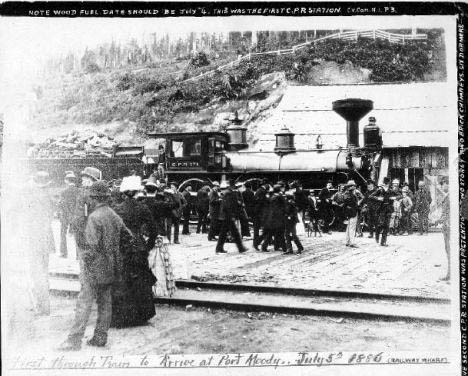
25 June 2006
It's a Stop on the Way to Making a
Nation

In this archival photo, courtesy of the Port Moody Station museum, a crowd
gathers around the first passenger train to arrive at what was then a pioneer community. There was no golden spike, contrary to
community legend, but Port Moody was the terminus of the original CPR line until a branch line was built to the Vancouver waterfront.
According to museum curator Jim Millar, below, CPR's original charter stated that the rail line terminus is supposed to be the first
navigable tide water.
Port Moody British Columbia - If it weren't for the
building that stood where Jim Millar crouches next to the railway tracks in the accompanying Tri-City News photo, children
might not be lining up to get Canadian flags painted on their cheeks next Saturday, 1 Jul 2006.
It's why the curator of the Port Moody Station Museum chose it as the place with the most significant national history.
"I think it's the most important spot, and the least known," he said. "The station was torn down in 1961 when it was the
oldest CPR station in British Columbia, and they didn't have the foresight then to try to keep it."
The building, probably constructed circa 1882-1884 was used by B.C. Union Oil in 1910, then by British American when the
site of Pacific Coast Terminals was a refinery.
"I think it's one of the biggest tragedies in Port Moody, actually. The Canadian Centennial was only six years away when they tore
it down. It was offered to the city for $1 and they turned it down," he said.
"That station was the original building built by the San Francisco Bridge Company as the western terminus of the CPR."
The first scheduled passenger train arrived 4 Jul 1886, but the first train arrived 8 Nov 1885 the day after
the last spike was driven in Craigellachie, near Revelstoke. (The track was laid from Port Moody to meet with track laid east to west.)
"There was never a golden spike, and the last spike wasn't driven in Port Moody, but the legend has sort of stuck."
On 23 May 1887 the first train arrived in Vancouver on the branch line, an offshoot of the main line which terminated in
Port Moody.
"Technically, it still is a branch line," Millar said. "I'd have to check on this, but they'd have to change the charter
for the CPR, which says the terminus is supposed to be the first navigable tidal water."
The Port Moody museum is housed in the second CPR station. "Why CP built it, I don't know, other than they sort of wanted to forget
about Port Moody as a terminus," he said.
Sometime after 1907, the company built a second station near the present-day location of Reichhold Ltd., near Douglas
Street. In 1945, this second station was moved closer to town.
"They cut it into two pieces and jacked it up, put it on the railway track, put an engine on it and pulled it to Queens
Street," Millar said. "Most people think the original station in its original location was Queens Street, but it was at Queens
Street from 1945 to 1978.
"There is a sign on the Trans Canada Trail for the location of the original station, but that's the only thing around that lets
anybody know. Now there's just a couple of tracks.
"It's what brought B.C. into Confederation," Millar said. "Without that train, there'd be no Canada Day in B.C. - not
like we know it today."
|